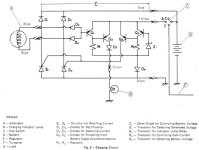allenp
Silver Member
evofxdwg - Nice idea, however, I do have a concern. Let me begin by saying that I am in NO way an expert on automotive regulators.
1.) The LM338 is limited to 5 amps continuous, with surge currents up to 12 amps. If you use the headlights frequently, you may have an issue with the regulator not being able to keep the battery charged. From what I remember on the LM338, if the load exceeds 5 amps, the output voltage will drop to keep the heat dissapation of the LM338 within tolerance.
You could add a few darlington pairs, or a few simple 2N3055 series pass transistors, to increase the load capibility, however, by the time you add up the cost and time you may be better off to go back OEM. Of course, this depends on whether or not you treat this as a fun project or science fair experiment /forums/images/graemlins/smile.gif
2.) The filter capacitor (C1) may need to be much larger 1000 mfd. While ripple is not much of a concern to this application, I have no idea what ripple will do the LM338 under full load.
Hope this helps.
Allen
1.) The LM338 is limited to 5 amps continuous, with surge currents up to 12 amps. If you use the headlights frequently, you may have an issue with the regulator not being able to keep the battery charged. From what I remember on the LM338, if the load exceeds 5 amps, the output voltage will drop to keep the heat dissapation of the LM338 within tolerance.
You could add a few darlington pairs, or a few simple 2N3055 series pass transistors, to increase the load capibility, however, by the time you add up the cost and time you may be better off to go back OEM. Of course, this depends on whether or not you treat this as a fun project or science fair experiment /forums/images/graemlins/smile.gif
2.) The filter capacitor (C1) may need to be much larger 1000 mfd. While ripple is not much of a concern to this application, I have no idea what ripple will do the LM338 under full load.
Hope this helps.
Allen

